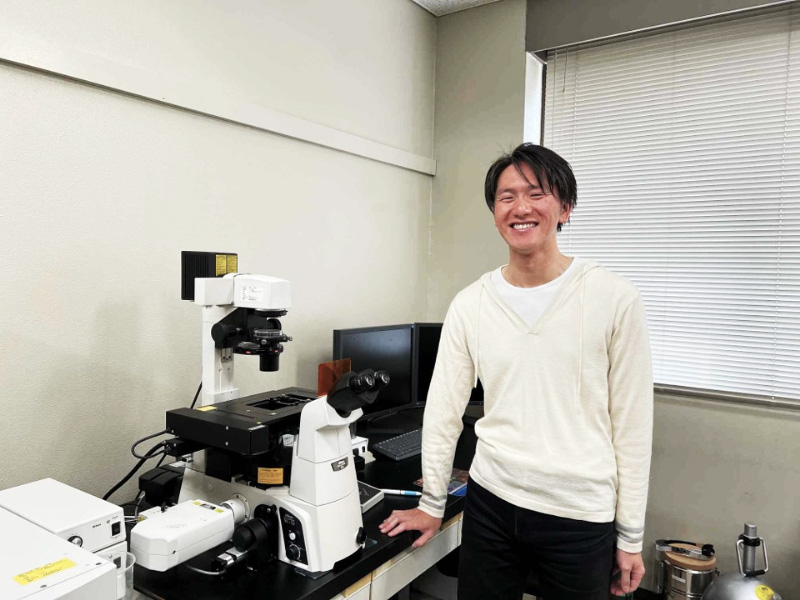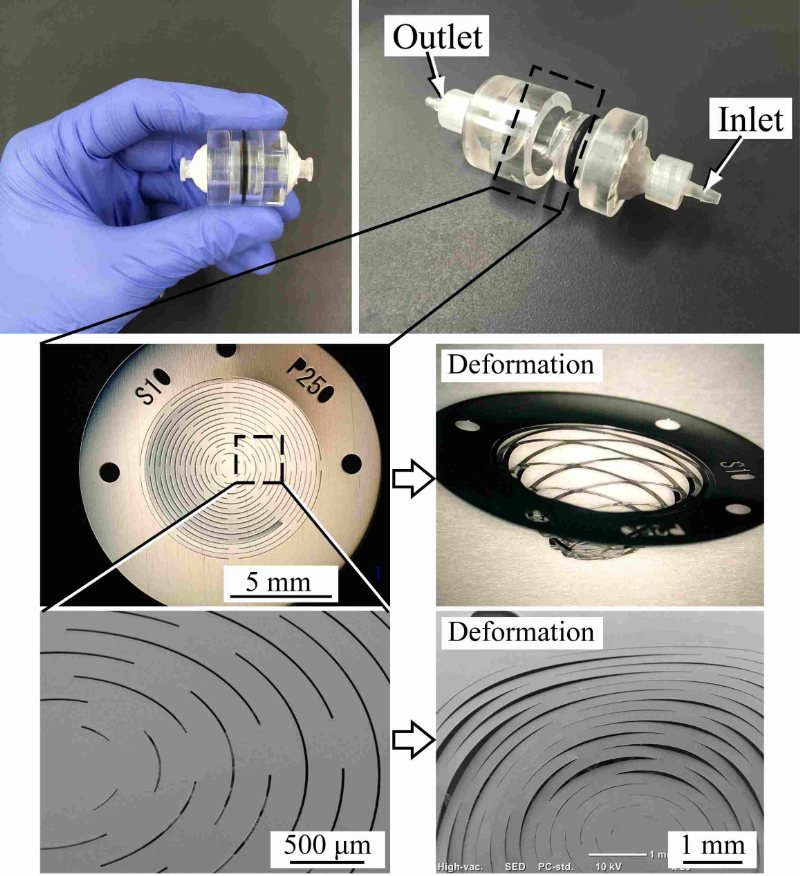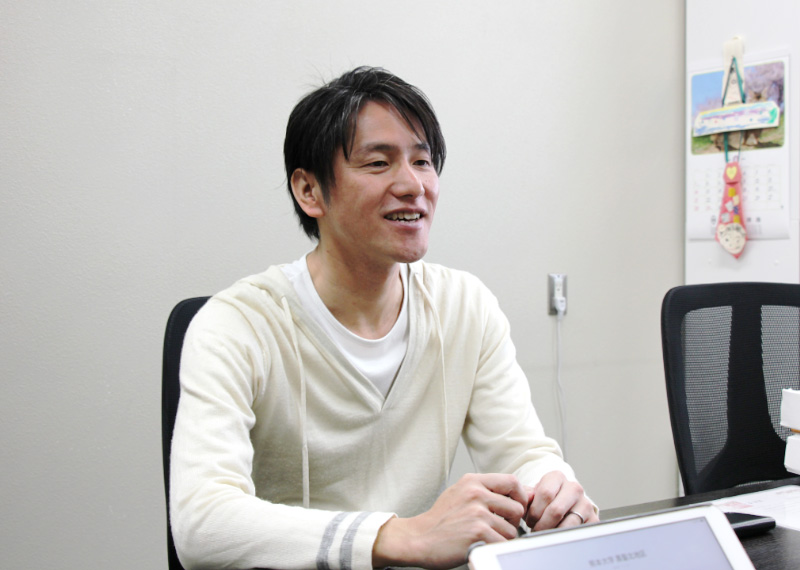A small, palm-sized device explores new paths in medical care!


Dr. Yuta NAKASHIMA
Associate Professor, Division of Biomedical Engineering, Faculty of Advanced Science and Technology
In this issue, Associate Professor Yuta Nakashima, who has specialized in mechanical engineering since his university days, although he longed for a career in medicine when he was a child. He is now pursuing various research projects that combine engineering with medicine and pharmacy with the belief that “engineering can make many people happy, even if it does not involve direct contact with patients”.
Developed a device that enables early detection of cancer
What kind of research are you doing?
Dr. Nakashima: My research involves the application of engineering technologies, especially in the micro and nano fields, to medicine, pharmacy, and biotechnology. One example is the development of a device for detecting cancer cells. Since the device is very small and fits in the palm, I am applying the technology used in the manufacturing process of small semiconductors. It is a technology used to draw very fine lines that are used to assemble semiconductor electronic circuits and so on.
How does detecting cancer cells work?
Dr. Nakashima: The device can catch cancer cells by simply flowing 1ml of blood through it. The device contains a disk-shaped microfilter about 5mm in diameter. The filter has microscopic incisions 5 microns wide. When blood flows through this filter, blood cells and cancer cells, which are about 20 microns in diameter, get trapped on the filter and cause it to clog. This makes it difficult for the blood to flow and generates a force that pushes against the filter. This force causes the filter to deform into a cage shape.
When deformed, the width of the 5 micron line is stretched and widened, and cells drop out of it. By placing a nucleic acid aptamer, which binds to a protein specifically expressed on cancer cells, on the filter, the cancer cells are attached to the aptamer and will not fall out. This is how cancer cells are caught.
There are approximately 5 billion blood cells in a milliliter of blood. Among them, it is said that only one to ten cancer cells are contained, but this device can find them.

Left: A sample of the device. In side the clear case is a microfilter that captures cancer cells.
Bottom: How cells ride on the filter and the filter deforms to catch only cancer cells.

Dr. Nakashima: There is also a Positron Emission Tomography (PET) test for cancer, but this test doesn’t detect cancer when the size of the cancer is less than 1 mm because it does not show up as an image. Also, it is difficult to take a PET test, which is time-consuming and costly, at a stage when it is not clear whether cancer is present or not. In contrast, this device can detect the presence of cancer with only 1ml of blood. Moreover, the device is small and palm-sized, and there is no need for a large device.
However, at this stage, we cannot tell where the cancer is located, so if we use this device to detect the presence of cancer before PET test, it would lead to more efficient testing and treatment.
Do you think that practical application is in the near future?
Dr. Nakashima: We still have a long way to go because we need a license to be able to use it as a medical device that can be used to determine whether or not a patient has cancer and to make treatment decisions.
However, this device is effective not only for testing whether a patient has cancer, but also for monitoring the progress of cancer patients during treatment and checking for cancer recurrence. The blood of patients undergoing anticancer drug treatment is tested, and if the number of cancer cells is reduced, it indicates that the anticancer drug is effective. It can also be used to check for cancer recurrence after surgery to remove it. I think it won’t be long before this device can be used for such checks during treatment and after prognosis.
The inspiration came from a child’s insect net and Tanabata decorations!
Why did you start this research?
Dr. Nakashima: I originally specialized in mechanical engineering, but until elementary, junior high, and high school student, I was interested in a career in medicine, such as doctors and pharmacists. But I didn’t have enough talent for that (laughs).
But I began to think that I could make many people happy even if I did not work directly with patients, and I wanted to try it in engineering. As I learned various things, I learned that there is a technology for handling cells using a process for making small objects called semiconductors, and I started this research because I wanted to connect this technology to medicine and pharmacy.
I got the idea for the method of deforming the disk-shaped filter to catch cancer cells from an insect net when my sons and I were catching insects. For example, the nets that catch garbage in drains are also three-dimensional. If you want to catch something, a three-dimensional object is more efficient. Then I thought of kirigami (paper cutout art), the paper used to make Tanabata decorations. If you cut a flat piece of paper well, it becomes three-dimensional, right? That led me to this research, which combines paper cutting and the process of making semiconductors, which are flat.

No matter what specialty you choose, you can connect it to what you want to do some day
It is a development that will be useful not only in the medical field, but in research as well.
Dr. Nakashima: Yes, we also aim to commercialize this device as a physical device for research.
For example, if a patient’s cancer cells are isolated with this device, they can be cultured. If the cells can be cultured, it will be possible to analyze the expression of cancer genes to determine the resistance of the cancer cells to drugs, and to determine which anti-cancer drug is best suited for the patient. I believe this will contribute to personalized medicine.
Apart from device development, I am also working on a technology that utilizes the same semiconductor fabrication process to assemble cells as you wish and combine them to create organs and tissues.
This technology can be used in drug discovery research as an example. In drug discovery research, it may happen that a drug is effective for cells arranged on a flat surface, but not for cells arranged in a three-dimensional form, such as organs, or when placed in a human body for clinical trials. If we have organs and tissues assembled from cells in three dimensions, we can use them for drug screening and other purposes, so we are working on this research together with professors of pharmaceutical sciences.
I believe that my role is to create tools that will be used by professors who specialize in mechanical engineering and research in the medical world, medicine, pharmacy, science and other fields.
It is very cross-disciplinary research!
Dr. Nakashima: In engineering, you cannot diagnose and treat the patient directly. However, mechanical and control engineering can be useful in the medical field, and now I am able to connect the field of engineering to what I wanted to do as a child. If you have a passion to do something, you can connect to it no matter what specialty you choose. I hope that you will find what you want to do while carefully considering what you are interested in and what you are good at.

Related links:
Researchmap
Bioengineering Lab.
